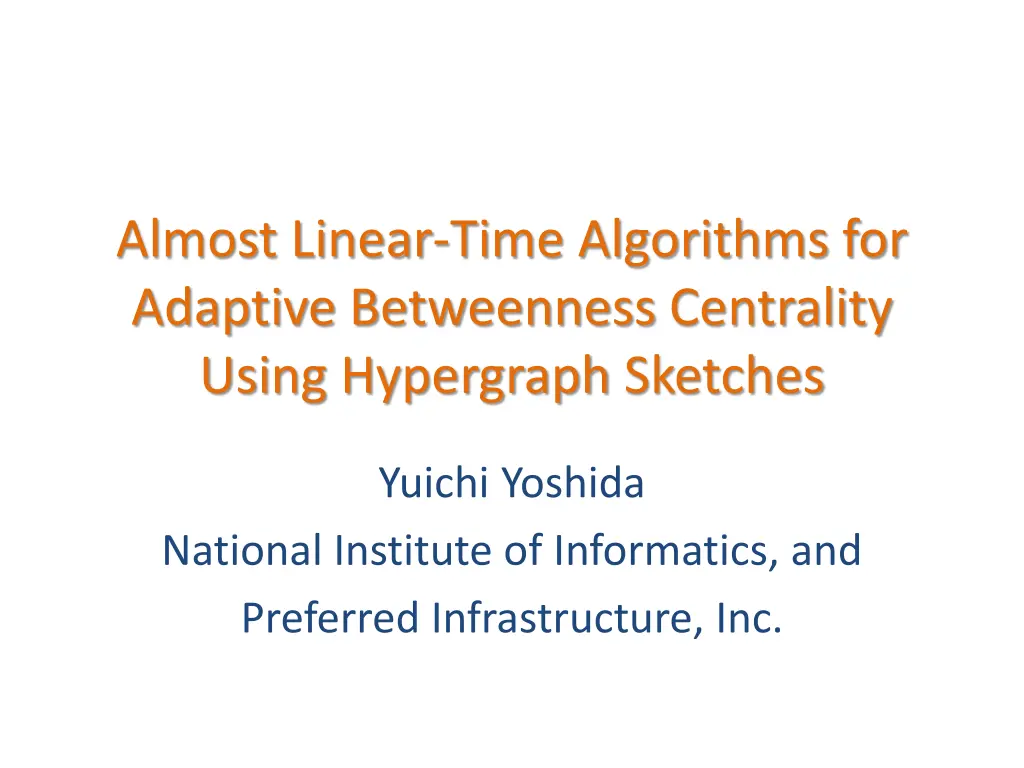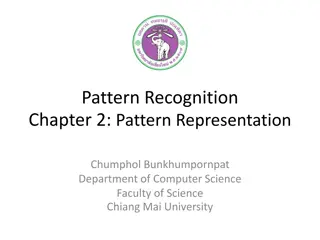
Adaptive Betweenness Centrality Algorithms Using Hypergraph Sketches
Explore almost linear-time algorithms for adaptive betweenness centrality computation through hypergraph sketches. Discover the importance of centrality in network science and learn about coverage centrality, betweenness centrality, and their applications in community detection algorithms.
Download Presentation

Please find below an Image/Link to download the presentation.
The content on the website is provided AS IS for your information and personal use only. It may not be sold, licensed, or shared on other websites without obtaining consent from the author. If you encounter any issues during the download, it is possible that the publisher has removed the file from their server.
You are allowed to download the files provided on this website for personal or commercial use, subject to the condition that they are used lawfully. All files are the property of their respective owners.
The content on the website is provided AS IS for your information and personal use only. It may not be sold, licensed, or shared on other websites without obtaining consent from the author.
E N D
Presentation Transcript
Almost Linear-Time Algorithms for Adaptive Betweenness Centrality Using Hypergraph Sketches Yuichi Yoshida National Institute of Informatics, and Preferred Infrastructure, Inc.
Centrality Centrality of a vertex how important it is Important notion in network science Centralities based on shortest paths Many s.p. pass through the vertex is important Coverage centrality Betweenness centrality Closeness centrality
Coverage centrality A pair (s, t) is covered by v: s-t s.p. passes through v Coverage centrality C(v): How many fraction of pairs are covered by v v
Coverage centrality A pair (s, t) is covered by v: s-t s.p. passes through v Coverage centrality C(v): How many fraction of pairs are covered by v t v s
Coverage centrality A pair (s, t) is covered by v: s-t s.p. passes through v Coverage centrality C(v): How many fraction of pairs are covered by v v t s
Coverage centrality A pair (s, t) is covered by v: s-t s.p. passes through v Coverage centrality C(v): How many fraction of pairs are covered by v v Betweenness centrality considers how much fraction of s-t s.p. pass through v.
Applications of CC / BC Community detection [Girvan-Newman s alg] Choose the vertex of highest BC.
Applications of CC / BC Community detection [Girvan-Newman s alg] Choose the vertex of highest BC.
Applications of CC / BC Community detection [Girvan-Newman s alg] Choose the vertex of highest BC. Remove the vertex
Applications of CC / BC Community detection [Girvan-Newman s alg] Choose the vertex of highest BC. Remove the vertex Repeat, say, k times
Applications of CC / BC Community detection [Girvan-Newman s alg] Choose the vertex of highest BC. Remove the vertex Repeat, say, k times
Applications of CC / BC Community detection [Girvan-Newman s alg] Choose the vertex of highest BC. Remove the vertex Repeat, say, k times
Applications of CC / BC Distance oracle [Akiba et al. SIGMOD 13] Targeted immunization No good to compute CC / BC in the original graph. Seems we need to compute CC / BC adaptively: for i = 1 to k : vi vertex of highest CC / BC No longer consider pairs covered by vi
Adaptive centrality Previous methods take at least quadratic time Exact Approximate (knm/ 2) O(kn2m) Adaptive CC (km/ 2) [BP08] Adaptive BC Approximate = approximate CC / BC to within O(knm) [Bra01]
Our contributions Compute the ordering based on adaptive centrality in almost linear time! Time complexity Adaptive CC: O((n + m)log n / 2) Adaptive BC: O((n + m)log n / 2) (in practice) ( : error parameter)
Our contributions Compute the ordering based on adaptive centrality in almost linear time! Theoretical guarantee The output is a (1-1/e)-approximation to a certain optimization problem. Experiments CC/BC of our method CC/BC of exact method. sometimes 1000x faster than previous algorithms
Rephrase the problem Coverage centrality C(S) of a vertex set S V := fraction of pairs covered by a vertex in S C(v | S) := C({v} S) C(S) Want to compute the following ordering for i = 1 to k: vi argmaxvC(v | v1, ,vi -1). = Greedy method for maximizing C( )
Our method: sketching by hypergraph Construct a hypergraph H as follows for i = 1 to M = O(log n/ 2): Sample a pair (s, t) uniformly at random. Add the hyperedge comprising s-t s.p to H. Time complexity: O((n+m)M).
Our method: sketching by hypergraph Find the ordering as follows. for i = 1 to k : vi argmaxvdH-{v1, ,vi-1}(v). v2 v1 Suffices to keep degrees in a hypergraph Time complexity: O((n+m)M).
Correctness EH[dH(v) / M] = Prst[dH(v) increases] = C(v) C(v) can be approximated by dH(v) EH[dH-S(v) / M] = Prst[dH-S(v) increases] = C(v | S) C(v | S) can be approximated by dH-S(v)
Centrality compared to the exact method Dataset: p2p-Gnutella k vs CC k vs BC M = 4K or 16K up to 1% of error.
Running time of computing adaptive CC (# of edges < 100K) M = 1K k = 50 100000 10000 Exact Sampling This work 1000 sec 100 10 1 0.1 Facebook ca-GrQc Gnutella k = n 100000 10000 Exact Sampling This work 1000 sec 100 10 1 0.1 Facebook ca-GrQc Gnutella Exact method did not finish in 12 hours.
Running time of computing adaptive CC (# of edges < 10M) M = 1K k = n 1000 100 sec 10 1 Epinions Enron Twitter Google Skitter
Summary Almost linear time algorithm for adaptive BC/CC. Provable guarantee: (1-1/e)-approximation. Confirmed accuracy and efficiency by experiment. Adaptive BC/CC are now available in applications involving large networks. Future work Even faster Other centralities, say, closeness centrality






















